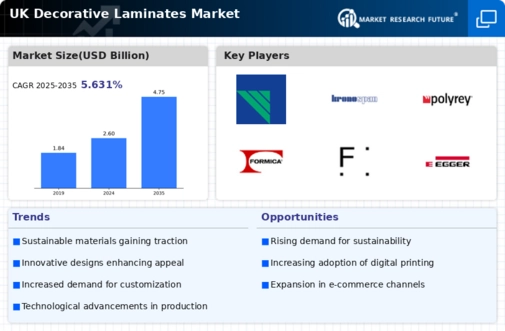Expansion of the Construction Sector
The ongoing expansion of the construction sector in the UK significantly influences the decorative laminates market. With a robust pipeline of residential and commercial projects, the demand for decorative laminates is expected to rise. The construction industry is projected to grow by approximately 4% annually, leading to increased utilization of decorative laminates in various applications, including wall panels, furniture, and flooring. This growth is attributed to the need for durable, cost-effective, and visually appealing materials that can withstand the rigors of modern construction. As architects and designers increasingly specify decorative laminates for their projects, the market is likely to see a corresponding increase in production and innovation, further solidifying its position within the broader construction landscape.
Rising Demand for Aesthetic Interiors
The decorative laminates market experiences a notable surge in demand driven by the increasing consumer preference for aesthetically pleasing interiors. Homeowners and businesses alike are investing in interior design, seeking materials that enhance visual appeal. This trend is particularly pronounced in urban areas, where space optimization and style are paramount. The market data indicates that the decorative laminates market is projected to grow at a CAGR of approximately 6.5% over the next five years in the UK. This growth is fueled by the rising disposable income of consumers, allowing for greater expenditure on home improvement and renovation projects. As a result, manufacturers are focusing on producing a diverse range of designs and finishes to cater to evolving consumer tastes, thereby propelling the decorative laminates market forward.
Increased Focus on Interior Design Trends
The decorative laminates market is significantly impacted by the heightened focus on interior design trends among consumers and businesses. As individuals seek to create unique and personalized spaces, the demand for decorative laminates that offer versatility and customization options is on the rise. Market data suggests that approximately 30% of consumers prioritize design flexibility when selecting materials for their interiors. This trend encourages manufacturers to innovate and provide a wider array of textures, colors, and finishes. Additionally, the rise of social media platforms showcasing interior design ideas has further fueled consumer interest in decorative laminates, as individuals aspire to replicate trendy looks in their own spaces. Consequently, the decorative laminates market is likely to benefit from this growing emphasis on design aesthetics.
Sustainability and Eco-Friendly Materials
The increasing consumer awareness regarding sustainability is reshaping the decorative laminates market. As environmental concerns gain prominence, there is a growing demand for eco-friendly materials that align with sustainable practices. Manufacturers are responding by developing decorative laminates that utilize recycled materials and environmentally friendly production processes. This shift is evident in the market, where eco-friendly decorative laminates are projected to account for approximately 25% of total sales by 2026. The emphasis on sustainability not only appeals to environmentally conscious consumers but also aligns with regulatory trends promoting green building practices. As a result, the decorative laminates market is likely to see a rise in the adoption of sustainable products, enhancing its appeal in the competitive landscape.
Technological Advancements in Manufacturing
Technological advancements in manufacturing processes are playing a crucial role in shaping the decorative laminates market. Innovations such as digital printing and advanced surface treatments are enabling manufacturers to produce high-quality laminates with intricate designs and superior durability. These advancements are expected to enhance product offerings, allowing for greater customization and improved performance characteristics. Market analysis indicates that the adoption of new technologies could lead to a reduction in production costs by approximately 15%, thereby making decorative laminates more accessible to a broader range of consumers. Furthermore, as manufacturers invest in research and development, the decorative laminates market is likely to witness a wave of innovative products that cater to evolving consumer preferences and industry standards.






















Leave a Comment